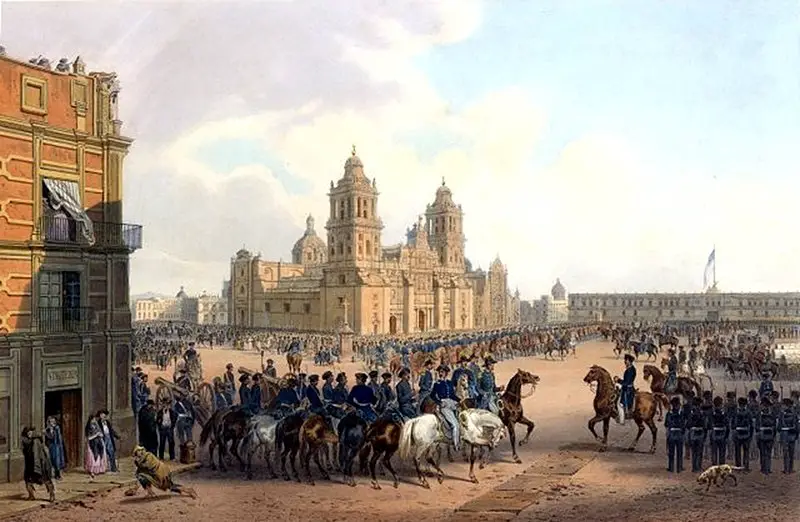More land
Europeans had the idea that they had the right to claim as many countries and land that they could find. They believed that the spread of Christianity to other peoples was their responsibility and that this required that they take over everything and everyone that they came into contact with.
They also thought that the profits from these explorations were their right to take. This philosophy was carried over into the New World, and as more settlers and pioneers arrived in the colonies, their desire to expand and gain more land continued.
- In 1845 a phrase was established that identified this philosophy in the United States: “Manifest destiny.” This is the idea that God stood by and supported their expansion over land and people and that capitalism and democracy were part of this justification. It explained their belief in forcibly removing Native Indians from their lands and taking those lands for their own use. Manifest destiny was also used as a way to condone slavery.

- The 19thcentury in the United States brought about high immigration and birth rates. The population was growing from 5 million residents in 1800 to over 23 million by the 1850s. The economy as it stood couldn’t support the population, and this was shown in both the 1819 and 1839 depressions. The only choice that people felt that they had was to move towards the west, where they saw new opportunities.
- In 1803 President Thomas Jefferson coordinated the Louisiana Purchase, which added around 828,000 square miles to the United States. This almost doubled the size of the country and included land from the Mississippi River to the Rocky Mountains. Jefferson also sponsored the Lewis and Clark expedition, which explored the western area as well as started the process of gaining Spanish Florida that was finally done under President Monroe. The area didn’t include what is now Texas, which would be completed in the future.
- President Monroe’s speech to Congress in 1823 spoke of Manifest Destiny and acted as a warning to European countries to not interfere as the expansion to the west continued. This was a threat to Europeans that if they tried to colonize any of the American continents, it would be viewed as an act of war. This policy was eventually developed into the Monroe Doctrine.
- When Mexico won its independence from Spain, they still held the area that is known as Texas today. More Americans were settling in Texas, and the Mexicans passed a law in 1830 that suspended immigration to the area. This didn’t change the fact that the population of Texas included a higher number of settlers than those that were Hispanic.
- Texas became independent in 1836 and wanted to become a new state. Fearing a war with Mexico, both Andrew Jackson’s and Martin Van Buren’s administrations opposed making Texas a state. Others that were against it thought that it was an excuse to continue to expand slavery. It wasn’t until 1844 that President John Tyler supported the idea, and Texas was eligible to be a state, and later it was added as one of the states in the U.S.
- The line between the United States and Canada was drawn in a treaty in 1842 between the United States and Great Britain. However, it didn’t address the Oregon Territory, which was defined as the area from the Rocky Mountains to the Pacific Coast. This covered what we now refer to as Oregon, the State of Washington, Idaho, and a majority of British Columbia.
- President Polk was a supporter of Manifest Destiny and believed that these areas should be part of the United States. His campaign slogan was “54˚ 40’ or fight!” This referred to the boundary of Oregon, which was latitude 54˚ 40’. He knew that if the United States gained those territories that it would be easier to gain California from Mexico. By 1846 Polk’s administration made a compromise with Great Britain to split the border at the 49th
- Even though the Oregon territory had been gained, the United States was now entering a war with Mexico for the expansion of land. In 1848 the Mexican-American War ended with the Treaty of Guadalupe Hidalgo, and the U.S. gained what is now California, Arizona, Colorado, New Mexico, Nevada, Utah, and Wyoming.
Q&A:
What does Manifest Destiny mean?
The idea that God stood by and supported their expansion over land and people and that capitalism and democracy was part of this justification.
What major event with the American population prompted the expansion of land?
The population was growing from the 5 million residents in 1800 to over 23 million by the 1850s.
What did President Thomas Jefferson coordinate that almost doubled the size of the U.S.?
The Louisiana Purchase
What was the name of the 1823 belief that Europeans should not interfere with the expansion of land in the U.S.?
The Monroe Doctrine
What was the name of the treaty signed with Mexico that allowed the United States to gain what would now be seven more states?
Treaty of Guadalupe Hidalgo
What area was excluded in the American and Great Britain borders for the U.S. and Canada?
The Oregon Territory



